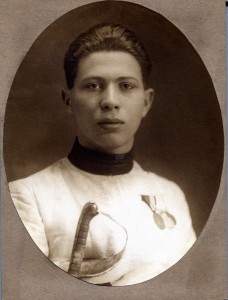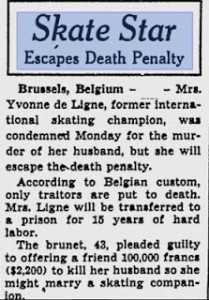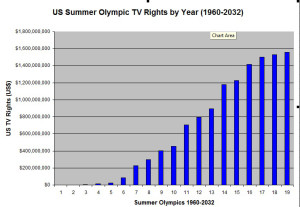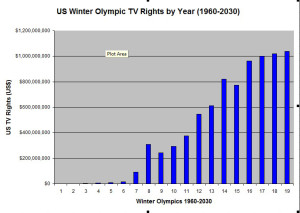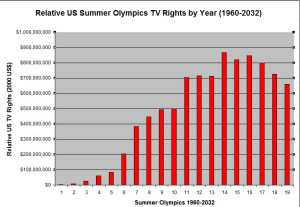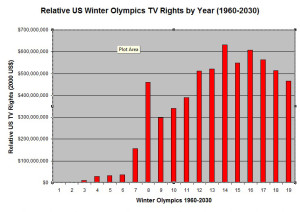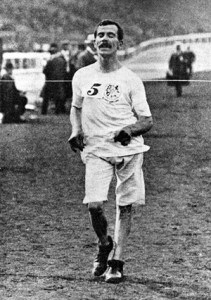As a group that delves in the world Olympic statistics, when Aleksandr Zubkov won a gold medal in bobsledding at Sochi this February, something immediately struck us about that victory. Zubkov had first competed in the Winter Olympics in 1998, but this was his first gold medal – 16 years from his Olympic début to the gold medal. We wondered – is this a record, and what are the records for the longest time it takes an athlete to win an Olympic medal or gold medal, from their Olympic début, to the day they win the medal.
Now we are only considering times to the actual year of the Olympics in which the medal was won. We’re not going to get into cases like Ingemar Johansson, the Swedish heavyweight boxer, who was disqualified in the 1952 final and was not awarded a silver medal initially, only to receive it in 1982 after the IOC rescinded that decision. Other similar cases are several of the more recent doping disqualifications several years after the Olympics, notably Marion Jones and Lance Armstrong, the case of Jim Thorpe, whose family finally received his gold medal (again) in 1983, or the 1952 boxing bronze medalists who did not receive their medals until 1970 (see my recent article on this in Journal of Olympic History – “The 1952 Olympic Boxing Bronze Medals”)
So we’ve worked out the stats on this somewhat arcane bit of Olympic trivia, and yes, Zubkov took longer to win a gold medal than any male winter Olympic gold medalist ever. Its somewhat unusual that it takes this long for Olympic medalists or gold medalists to win their first medals, or golds. Since 1896, there have been 26,403 Olympic athletes win medals (out of a total of 126,587 known Olympic competitors), and 21,727 of those medalists won the medals at their début Olympics – or about 82% of the time. For the gold medalists, there are 9,706 of them, of which 7,127 won their gold medals at their first Olympics – or about 76%.
So its unusual to wait as long as these athletes did – and it takes more than waiting. It takes a lot of training and perseverance.
Longest Time – Olympic Début to Medal, Men, Summer
[table]
Range,Name (NOC-Sport; Début Year-Year of Medal)
36,Ian Millar (CAN-EQU; 1972-2008)
32,Louis Noverraz (SUI-SAI; 1936-1968)
24,Ioannis Theofilakis (GRE-SHO; 1896-1920)
24,Henri Jobier (FRA-FEN; 1900-1924)
24,Juan Esteban Curuchet (ARG-CYC; 1984-2008)
24,Nick Skelton (GBR-EQU; 1988-2012)
20,Paulin Lemaire (FRA-GYM; 1900-1920)
20,Raymond Bru (BEL-FEN; 1928-1948)
20,Édouard Yves (BEL-FEN; 1928-1948)
20,Norman Cohn-Armitage (USA-FEN; 1928-1948)
20,Herman Whiton (USA-SAI; 1928-1948)
20,Marcel Stern (SUI-SAI; 1948-1968)
20,Hugo Simon (AUT-EQU; 1972-1992)
20,Michael Matz (USA-EQU; 1976-1996)
20,Peter Eriksson (SWE-EQU; 1984-2004)
20,Peter Charles (GBR-EQU; 1992-2012)
20,Carl Hester (GBR-EQU; 1992-2012)
[/table]
Ian Millar
The above are the 17 of the 20 times that it has taken an athlete 20 or more years to win their first Olympic medal. Two of the others are given in the lists: Max Houben (BEL-ATH/BOB; 1920-1948), with 28 years, and Ann Jensen-van Olst (DEN-EQU; 1988-2008), with 20 years. Houben actually competed in athletics in 1920 and competed at the Winter Olympics in bobsledding from 1928-48, so his Winter record is actually only 20 years, but it was 28 years from his first Olympic participation to his first Olympic medal, placing him third all-time, after Millar and Noverraz above. The third, not in any list, is Norwegian Yngvar Bryn, who won a silver medal in 1920 pairs figure skating. Although technically at the Summer Olympics, we count it with the Winter sports, and Bryn made his only other Olympic appearance in 1900 in athletics, 20 years before he won his figure skating medal.
Also notable on the above list is Michael Matz, who went 20 years before winning an Olympic medal in equestrian. Matz later became well-known for two non-Olympic events. In July 1989 he was aboard United Airlines flight 232 when it crashed and burned in Sioux City, Iowa. Matz heroically led three young children to safety from the plane, and then later returned to the burning wreckage to rescue an 11-month-old child. In 1998 Matz began training thoroughbred racehorses, among which was Barbaro, who won the 2006 Kentucky Derby, trained by Matz. In the Preakness, in which Barbaro was a heavy favorite, he broke down shortly after leaving the starting gate. After months of difficult surgeries and attempts to save his shattered right hind leg, the horse was put down in January 2007.
Longest Time – Olympic Début to Medal, Women, Summer
[table]
Range,Name (NOC-Sport; Début Year-Year of Medal)
20,Anne Jensen-van Olst (DEN-EQU; 1988-2008)
16,Cindy Neale-Ishoy (CAN-EQU; 1972-1988)
16,Nonka Matova (BUL-SHO; 1976-1992)
16,Jackie Silva (BRA-BVO; 1980-1996)
16,Ildikó Mincza-Nébald (HUN-FEN; 1992-2008)
16,Homare Sawa (JPN-FTB; 1996-2012)
12,37 athletes tied with 12.
[/table]
Jackie Silva won her Olympic medal, a gold, in 1996 beach volleyball, but she had made her Olympic début as an indoor volleyball player in 1980. Of note above, is the 16-year gap from début to medal for Japanese footballer Homare Sawa, a huge amount of time in such a physically demanding sport.
Longest Time – Olympic Début to Medal, Men, Winter
[table]
Range,Name (NOC-Sport; Début Year-Year of Medal)
20,Max Houben (BEL-BOB; 1928-1948)
18,Jari Kurri (FIN-ICH; 1980-1998)
18,Chris Chelios (USA-ICH; 1984-2002)
16,Todd Lodwick (USA-NCO; 1994-2010)
14,Brian Leetch (USA-ICH; 1988-2002)
14,Mike Richter (USA-ICH; 1988-2002)
14,Brian Shimer (USA-BOB; 1988-2002)
14,Scott Young (USA-ICH; 1988-2002)
14,Albert Demchenko (RUS-LUG; 1992-2006)
14,Oswald Haselrieder (ITA-LUG; 1992-2006)
14,Gerhard Plankensteiner (ITA-LUG; 1992-2006)
[/table]
Max Houben’s record is actually longer than 20 years. He made his Olympic début in 1920 in athletics, running the 200 metres and 4×100 relay at Antwerp. So it was actually 28 years from his Olympic début to his first Olympic medal, but that crossed over from Summer to Winter Games.
A similar situation exists for Norwegian Yngvar Bryn, who won a silver medal in 1920 pairs figure skating, which technically took place at the Summer Olympics, although we count that as with the Winter sports. Bryn made his first Olympic appearance in 1900 in athletics, running the 200 and 400 metres, so it was 20 years from his first Olympic appearance to his first medal, but again mixing Summer and Winter (in a sense).
Also of note in the above lists are the number of ice hockey players. Though a very physically demanding sport, this was caused by the introduction in 1998 of NHL players to the Olympics, which allowed several NHL veterans to return to the Olympics many years after their débuts.
Longest Time – Olympic Début to Medal, Women, Winter
[table]
Range,Name (NOC-Sport; Début Year-Year of Medal)
16,Maki Tabata (JPN-SSK; 1994-2010)
16,Alla Tsuper (BLR-FRS; 1998-2014)
12,Sylvie Daigle (CAN-STK; 1980-1992)
12,Blanca Fernández Ochoa (ESP-ASK; 1980-1992)
12,Svetlana Boyarkina-Zhurova (RUS-SSK; 1994-2006)
12,Tatyana Navka (RUS-FSK; 1994-2006)
12,Kristina Šmigun-Vähi (EST-CCS; 1994-2006)
12,Sabina Valbusa (ITA-CCS; 1994-2006)
12,Maëlle Ricker (CAN-SNB; 1998-2010)
12,Teja Gregorin (SLO-BIA; 2002-2014)
12,Tomoka Takeuchi (JPN-SNB; 2002-2014)
12,Christina Bertrup (SWE-CUR; 2002-2014)
[/table]
Maki Tabata
Sylvie Daigle competed at five Olympics, winning a gold medal in short-track speed skating in 1992, but she competed at her first two Olympics – 1980-84 – in long-track speed skating.
Longest Time – Olympic Début to Gold Medal, Men, Summer
[table]
Range,Name (NOC-Sport; Début Year-Year of Gold)
24,Henri Jobier (FRA-FEN; 1900-1924)
24,Juan Esteban Curuchet (ARG-CYC; 1984-2008)
24,Nick Skelton (GBR-EQU; 1988-2012)
24,Sergey Martynov (BLR-SHO; 1988-2012)
20,Anders Peter Nielsen (DEN-SHO; 1900-1920)
20,Heikki Savolainen (FIN-GYM; 1928-1948)
20,Herman Whiton (USA-SAI; 1928-1948)
20,Gustaf Adolf Boltenstern Jr. (SWE-EQU; 1932-1952)
20,Peter Charles (GBR-EQU; 1992-2012)
20,Carl Hester (GBR-EQU; 1992-2012)
20,Fredrik Lööf (SWE-SAI; 1992-2012)
[/table]
These 11 athletes are the only ones to take 20 or more years to win an Olympic gold medal – never happened by a woman or at the Winter Olympics. Most of the sports on this list are sailing, shooting, equestrian, or fencing, but especially noteworthy is Juan Esteban Curuchet, who won a gold medal in the 2008 Madison cycling event, 24 years after his Olympic career began.
Nick Skelton took 24 years to win his gold medal, but it could have been longer. He was named to the 1980 British Olympic team, but that team did not compete in Moscow, because of the boycott. Thus it was 32 years from being named to his first Olympic team to his gold medal.
Nick Skelton
Longest Time – Olympic Début to Gold Medal, Women, Summer
[table]
Range,Name (NOC-Sport; Début Year-Year of Gold)
16,Lia Manoliu (ROU-ATH; 1952-1968)
16,Jackie Silva (BRA-BVO; 1980-1996)
16,Josefa Idem-Guerrini (ITA-CAN; 1984-2000)
16,Eldece Clarke-Lewis (BAH-ATH; 1984-2000)
16,Pauline Davis-Thompson (BAH-ATH; 1984-2000)
16,Trine Solberg-Hattestad (NOR-ATH; 1984-2000)
16,Rumyana Dzhadzharova-Neykova (BUL-ROW; 1992-2008)
16,Fofão (BRA-VOL; 1992-2008)
12,24 athletes tied with 12.
[/table]
Jackie Silva competed at the 1980 and 1984 Olympics in indoor volleyball, returning to the Olympics in 1996 when beach volleyball was added to the Olympic Program, and winning her first Olympic medal, a gold alongside Sandra.
Longest Time – Olympic Début to Gold Medal, Men, Winter
[table]
Range,Name (NOC-Sport; Début Year-Year of Gold)
16,Aleksandr Zubkov (RUS-BOB; 1998-2014)
14,Maurilio De Zolt (ITA-CCS; 1980-1994)
14,Tomas Jonsson (SWE-ICH; 1980-1994)
14,Mats Näslund (SWE-ICH; 1980-1994)
14,Giorgio Vanzetta (ITA-CCS; 1980-1994)
14,Vladimír Růžička (CZE-ICH; 1984-1998)
14,Fulvio Valbusa (ITA-CCS; 1992-2006)
12,12 athletes tied with 12.
[/table]
Aleksandr Zubkov set this record at Sochi only a few months ago, and was the inspiration for this statistical research. As noted above several ice hockey players are on this list because of NHL veterans returning to the Olympics years after their Olympic débuts.
Longest Time – Olympic Début to Gold Medal, Women, Winter
[table]
Range,Name (NOC-Sport; Début Year-Year of Gold)
16,Alla Tsuper (BLR-FRS; 1998-2014)
14,Kateřina Neumannová (CZE-CCS; 1992-2006)
12,Sylvie Daigle (CAN-STK; 1980-1992)
12,Svetlana Boyarkina-Zhurova (RUS-SSK; 1994-2006)
12,Tatyana Navka (RUS-FSK; 1994-2006)
12,Kristina Šmigun-Vähi (EST-CCS; 1994-2006)
12,Maëlle Ricker (CAN-SNB; 1998-2010)
12,Shen Xue (CHN-FSK; 1998-2010)
12,Tina Maze (SLO-ASK; 2002-2014)
10,Manuela Di Centa (ITA-CCS; 1984-1994)
10,Emese Nemeth-Hunyady (AUT-SSK; 1984-1994)
10,Sylke Otto (GER-LUG; 1992-2002)
10,Gabriella Paruzzi (ITA-CCS; 1992-2002)
10,Kari Traa (NOR-FRS; 1992-2002)
[/table]
Alla Tsuper
Two athletes on the above lists competed in two Olympic sports, and one of them competed both at the Winter and Summer Olympics. Kateřina Neumannová was a cross-country skiier at the 1992, 1994, 1998, 2002, and 2006 Winter Olympics, winning her first medal in 1998 and her first gold medal in 2006. She also competed as a cyclist at the 1996 Summer Olympics. As noted above, Sylvie Daigle competed at 5 Olympics, competing in long-track speed skating in 1980 and 1984, and short-track in 1988, 1992, and 1994.
In addition, we should mention Clara Hughes, another Canadian, and a cyclist-speed skater. Hughes made her first Olympic appearance in 1996 in cycling, winning two bronze medals in the road race and individual time trial. She also competed in cycling in 2000 and 2012, but won no medals. She competed at the Winter Olympics in speed skating (long-track) in 2002, 2006, and 2010, winning her first gold medal in 2006 in the 5,000 metres, fully 10 years after her Olympic début, but that crossed from Summer to Winter Olympics.
Hughes is one of only 5 Olympians to have won medals in both the Winter and Summer Olympics, joining Eddie Eagan (USA-BOB/BOX), Jacob Tullin Thams (NOR-SAI/SKJ), Christa Luding-Rothenburger (GDR-CYC/SSK), and Lauryn Williams (USA-ATH/BOB). Williams was added to this list in Sochi with her bobsledding silver medal, after a gold medal at London in 2012 in the 4×100 relay.
